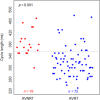When and how does a single ventricular premature beat initiate and terminate supraventricular tachycardia?
- PMID: 30993813
- PMCID: PMC6931473
- DOI: 10.1111/anec.12650
When and how does a single ventricular premature beat initiate and terminate supraventricular tachycardia?
Abstract
Background: The differential diagnosis of a supraventricular tachycardia (SVT) is accomplished using a number of pacing maneuvers. The incidence and mechanism of a single ventricular premature beat (VPB) on initiation and termination of tachycardia were evaluated during programmed electrical stimulation (PES) of the heart in patients with the two most common regular SVTs: atrioventricular re-entrant tachycardia (AVNRT) and orthodromic atrioventricular tachycardia (AVRT).
Methods: Three hundred and thirty-seven consecutive patients aged above 18 years with an inducible sustained AVNRT or AVRT were prospectively enrolled. Patients with more than one tachyarrhythmia mechanism were excluded. Two hundred and seventeen patients (64.4%) had typical slow/fast AVNRT and 120 (35.6%) had an orthodromic AVRT using a rapidly conducting accessory pathway for V-A conduction. In this cross-sectional study, we specifically report the analysis of tachycardia induction and termination by a single VPB.
Results: Tachycardia induction with a single VPB during sinus rhythm was seen in 7 of 120 AVRT and in only one of the 217 patients with AVNRT, (5.8% vs. 0.3%, p < 0.05). When a single VPB was delivered during basic ventricular pacing these values were 28% versus 4%, respectively, (p < 0.001). Termination of tachycardia by a single VPB was observed in nine (4.1%) patients with AVNRT and in 57 (47.5%) with AVRT (p < 0.001).
Conclusion: Initiation of SVT by a single VPB during sinus rhythm was uncommon and favored AVRT. Termination of SVT by a single VPB was commonly seen in AVRT but rarely in AVNRT. These findings can be of help when interpreting a noninvasive arrhythmia event recording.
Keywords: cardiac rhythm event recorders; electrophysiologic study; supraventricular tachycardia; tachycardia mechanisms.
© 2019 Wiley Periodicals, Inc.
Conflict of interest statement
There is no conflict of interest to disclose.
Figures





References
-
- Bennett, M. T. , Leong‐Sit, P. , Gula, L. J. , Skanes, A. C. , Yee, R. , Krahn, A. D. , … Klein, G. J. (2011). Entrainment for distinguishing atypical atrioventricular node reentrant tachycardia from atrioventricular reentrant tachycardia over septal accessory pathways with long‐RP tachycardia. Circulation: Arrhythmia and Electrophysiology, 4, 506–509. 10.1161/CIRCEP.111.961987 - DOI - PubMed
-
- Calvo, D. , Pérez, D. , Rubín, J. , García, D. , Ávila, P. , Javier García‐Fernández, F. , … Morís, C. (2018). Delta of the local ventriculo‐atrial intervals at the septal location to differentiate tachycardia using septal accessory pathways from atypical atrioventricular nodal re‐entry. EP Europace, 20, 1638–1646. 10.1093/europace/eux368 - DOI - PubMed
-
- Chow, S. , Shao, J. , & Wang, H. (2008). Sample size calculations in clinical research (2nd ed.) Boca Raton, FL: CRC Press Taylor & Francis Group; 6000 Broken Sound Parkway NW, Suite 300 Boca Raton, FL 33487-2742.
Publication types
MeSH terms
LinkOut - more resources
Full Text Sources

